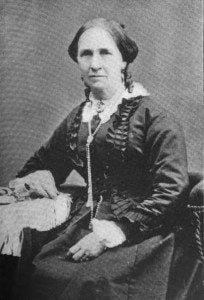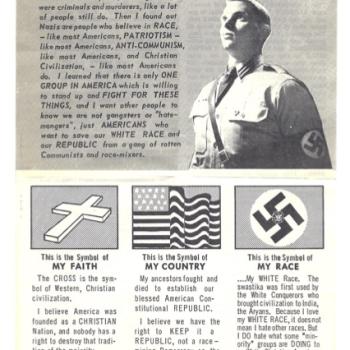Many observers of Mormonism have offered their thoughts on the recent statements on plural marriage published by the Church of Jesus Christ of Latter-day Saints. They discuss the origins of plural marriage and Joseph Smith’s own practice of polygamy; the living out of polygamy in early Utah; and the church’s abandonment of plural marriage between 1890 and 1906. You can access the three essays here.
I find the essays remarkable for their detail, especially in discussing topics previously eschewed by official church organs. For instance, we learn this about post-Manifesto polygamy (church leaders continued to authorize some plural marriages after promising to obey the law of the land in 1890):
The ledger of “marriages and sealings performed outside the temple,” which is not comprehensive, lists 315 marriages performed between October 17, 1890, and September 8, 1903. Of the 315 marriages recorded in the ledger, research indicates that 25 (7.9%) were plural marriages and 290 were monogamous marriages (92.1%). Almost all the monogamous marriages recorded were performed in Arizona or Mexico. Of the 25 plural marriages, 18 took place in Mexico, 3 in Arizona, 2 in Utah, and 1 each in Colorado and on a boat on the Pacific Ocean. Overall, the record shows that plural marriage was a declining practice and that Church leaders were acting in good conscience to abide by the terms of the Manifesto as they understood them.
One could debate the concluding sentence and instead suggest that church leaders circumvented the spirit and (on occasion) the letter of the Manifesto. Indeed, if the New York Herald accurately reported his views, George Q. Cannon suggested that he understood Canada and Mexico as proper and acceptable locations for the continued practice of plural marriage. I think church leaders’ acted in good conscience because they regarded Joseph Smith’s revelation on celestial marriage as more binding than their promise to obey the law of the land. As Kathleen Flake explains in her lucid and very teachable The Politics of American Religious Identity, only with the greatest reluctance did Mormon leaders subordinate their practices to state authority.
Yet the conclusion here is perhaps not the most important aspect of the paragraph. Were church leaders duplicitous? Perhaps. Keep in mind that the U.S. government demanded that the Latter-day Saints abandon a fiercely defended religious principle (however odious to most Americans then and now). What is remarkable in the statement is the information from the above-named ledger. It is remarkable that the church is now placing such information in the public sphere. We can then have a more informed debate over how to interpret the church’s post-Manifesto actions.
One topic still shrouded in a good deal of mystery is the nature of Joseph Smith’s thirty-some plural marriages:
Sealings for time and eternity included commitments and relationships during this life, generally including the possibility of sexual relations. Eternity-only sealings indicated relationships in the next life alone.
I am more familiar with proxy marriages than with eternity-only sealings. In proxy marriages, a woman was sealed to a living man for time and to a deceased man (often but not always her deceased husband) for eternity. In this case, any children resulting from the union would belong to the deceased man, the eternal husband.
Helen Mar Whitney, sealed to Joseph Smith at the age of fourteen, later observed that the marriage was for “eternity alone.” It is possible that the ceremony in this case was for “time and eternity” and that the marriage simply was not consummated.
The church’s recent statement also discusses Smith’s marriages to already married women:
Following his marriage to Louisa Beaman and before he married other single women, Joseph Smith was sealed to a number of women who were already married. Neither these women nor Joseph explained much about these sealings, though several women said they were for eternity alone. Other women left no records, making it unknown whether their sealings were for time and eternity or were for eternity alone.
These marriages are complex, as the experiences of Zina Huntington, Henry Jacobs, Joseph Smith, and Brigham Young ably illustrate. After marrying Henry Jacobs in 1841, Zina — following a long period of anguished prayer and searching — accepted Joseph Smith’s offer of plural marriage. She continued to live with Henry, and two months after her sealing to Smith, she gave birth to a son. While pregnant with Henry Jacobs’s second son, she was sealed to Brigham Young. Just prior to the exodus, Zina, Henry, and Brigham Young gathered in the Nauvoo Temple, in which a ceremony sealed her to Smith for eternity and as “husband & wife for time” to Young. “Henry B. Jacobs expressed his willingness that it should be so,” recorded the temple clerk.

Henry Jacobs apparently did think that his wife’s sealings to Smith and Young were for eternity alone. At least by 1846, however, that was not Brigham Young’s understanding. Zina and Henry Jacobs left Nauvoo together, but when he left for a mission to England, she joined Brigham Young’s household. Were the other marriages consummated prior to her separation from Henry Jacobs? There is no way to definitively answer that question. [There are a number of extremely helpful sources on Zina Huntington’s marriages, including Todd Compton’s chapter in In Sacred Loneliness; Martha Bradley’s Four Zinas, and Brian Hales’s discussion here.] The most simple conclusion about Nauvoo polygamy is that it was a mess. Joseph Smith left behind no clear instructions for his followers about how to live out plural marriage.
The recently published statements are remarkable. They generate headlines such as “Mormon Church Admits for the First Time that Joseph Smith Had a Fourteen-Year-Old Bride.” I don’t think the church ever trumpeted the fact that Joseph Smith was sealed to a girl of fourteen. But Andrew Jenson did include Helen’s sealing to Joseph in the May 1887 Historical Record. If this was a secret, it was a very open secret. In fact, during these years, the church marshaled evidence that proved that Joseph Smith had indeed practice plural marriage in order to rebut the charges of the Reorganized Church of Jesus Christ of Latter Day Saints. Of course, after 1890, the church became far less interested in talking about polygamy, Joseph Smith’s included. That, I think, proved to the church’s detriment in the end. The recent statements are intended, at least in part, to provide both information and spiritual reassurance to both church members and prospective converts.
Here is the church’s conclusion:
Plural marriage was among the most challenging aspects of the Restoration. For many who practiced it, plural marriage was a trial of faith. It violated both cultural and legal norms, leading to persecution and revilement. Despite these hardships, plural marriage benefited the Church in innumerable ways. Through the lineage of these 19th-century Saints have come many Latter-day Saints who have been faithful to their gospel covenants as righteous mothers and fathers; loyal disciples of Jesus Christ; devoted Church members, leaders, and missionaries; and good citizens and prominent public officials. Modern Latter-day Saints honor and respect these faithful pioneers who gave so much for their faith, families, and community.
Most outsiders seem to believe that the church should recognize plural marriage as an obvious human error. Given the church’s ecclesiology and sense of its history, such a step is not possible. For this outsider, plural marriage is not a reason for outrage (or for admiration). Instead, celestial and plural marriage reshaped not only Mormon families but Mormon identity and theology, was one issue among several in a decades-long struggle between the church and the U.S. government, and left behind a remarkably rich historical record of faith, bitter conflict, anguish, and perseverance.
















